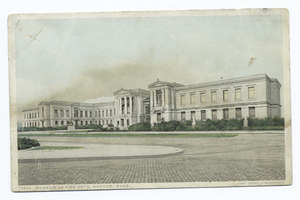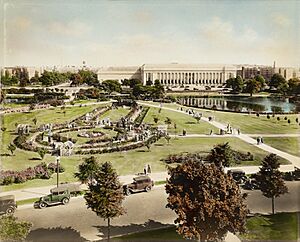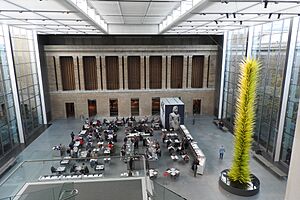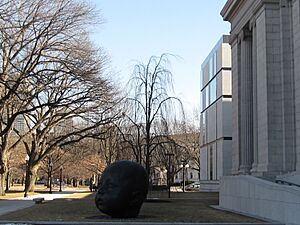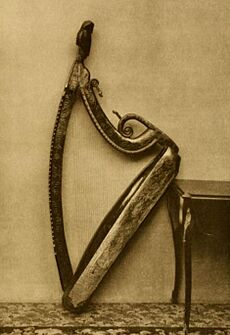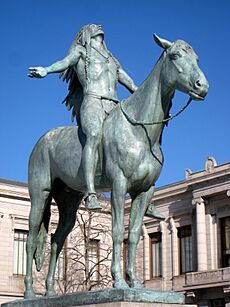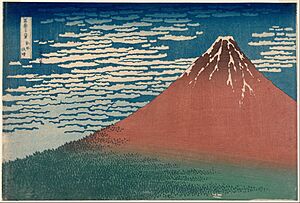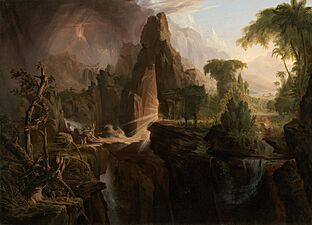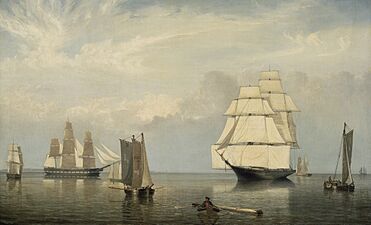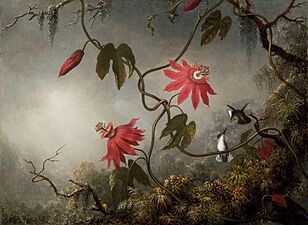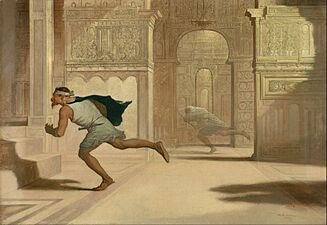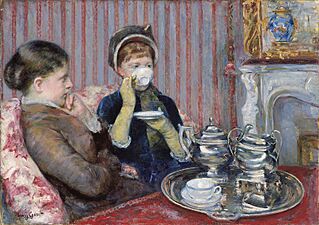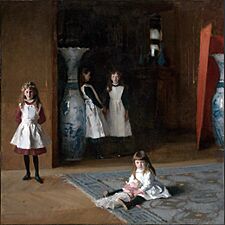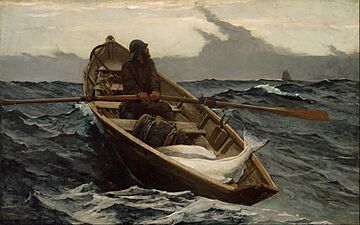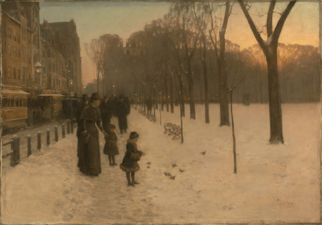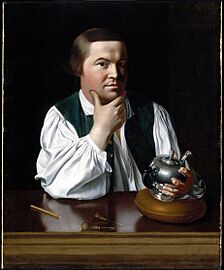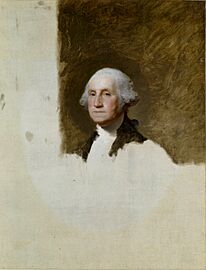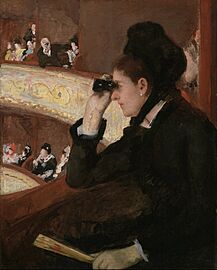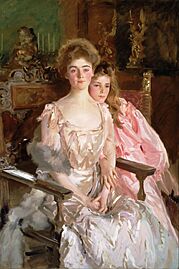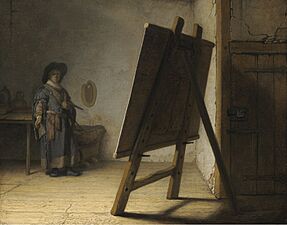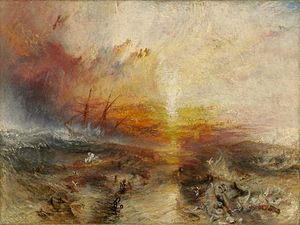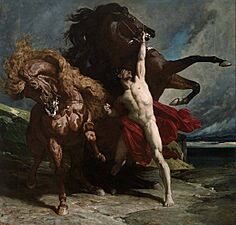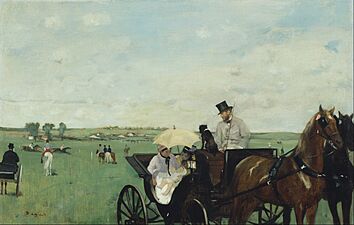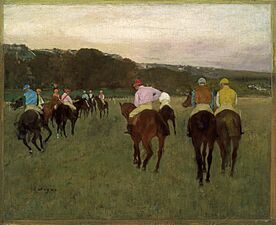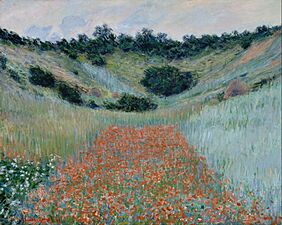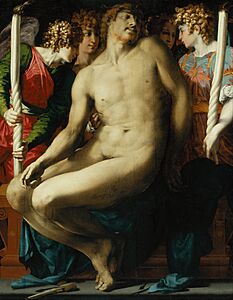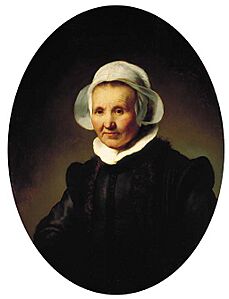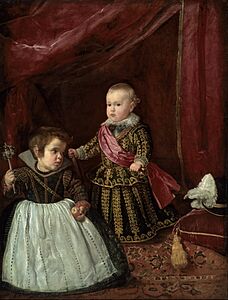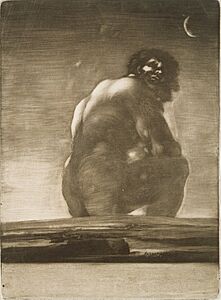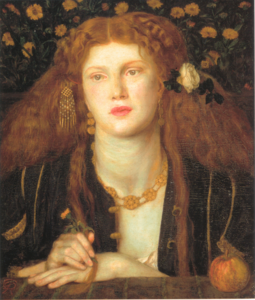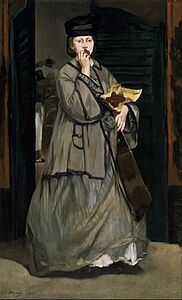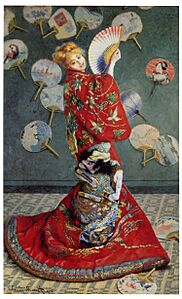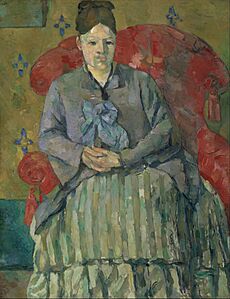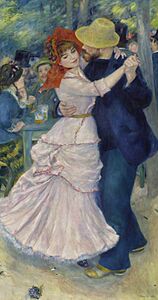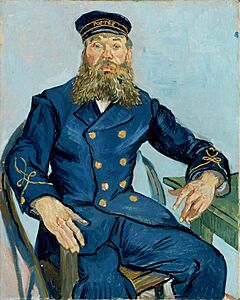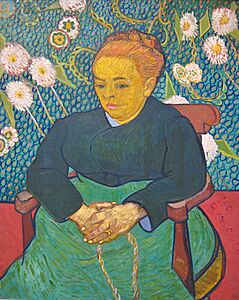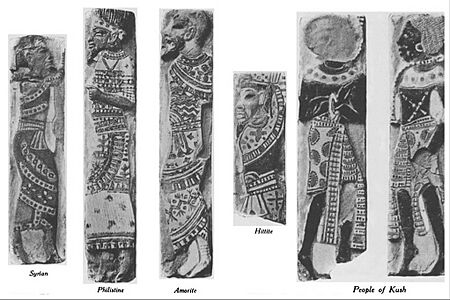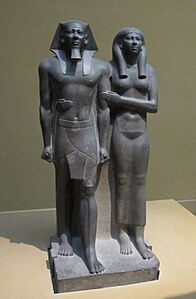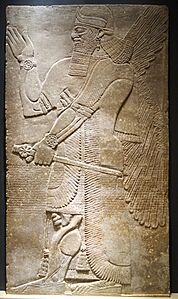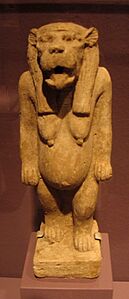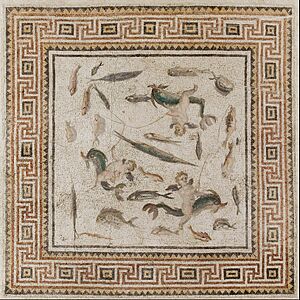Museum of Fine Arts, Boston facts for kids
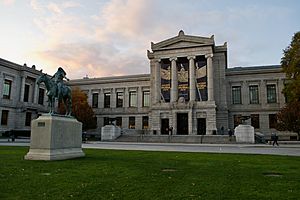
Museum of Fine Arts main entrance with the Appeal to the Great Spirit statue in the foreground
|
|
| Lua error in Module:Location_map at line 420: attempt to index field 'wikibase' (a nil value). | |
| Established | 1870 |
|---|---|
| Location | 465 Huntington Avenue Boston, MA 02115 |
| Type | Art museum |
| Accreditation | AAM |
| Visitors | 1,249,080 (2019) |
| Architect | Guy Lowell |
| Public transit access |
Green Line (E branch)
Museum of Fine Arts Orange Line
Ruggles Franklin Line
Ruggles Providence/Stoughton Line
Ruggles |
The Museum of Fine Arts (often called MFA Boston or MFA) is a famous art museum in Boston, Massachusetts, United States. It's one of the largest art museums in the world, based on how much space is open to visitors. The museum has over 450,000 artworks, including more than 8,000 paintings. This makes it one of the biggest art collections in North and South America. More than 1.2 million people visit the MFA each year.
The museum started in 1870 in Copley Square. It later moved to its current spot in the Fenway area in 1909. The museum is also connected to the School of the Museum of Fine Arts at Tufts, where students can study art.
Contents
History of the Museum
Early Years: 1870–1907
The Museum of Fine Arts began in 1870. Its first home was on the top floor of the Boston Athenæum, a library and cultural center. Most of its first artworks came from the Athenæum's own art collection. In 1876, the museum moved into a new building in Copley Square. This building was designed in a fancy Gothic Revival style, using a lot of special brick and terracotta from England.
After the MFA moved out in 1909, this original building was taken down. The Copley Plaza Hotel, now called the Fairmont Copley Plaza, was built in its place in 1912. During these early years, Charles Greely Loring, a former general, was the museum's first director from 1876 to 1902.
Growing Bigger: 1907–1999
In 1907, plans were made for a new, larger museum building on Huntington Avenue. This new location was in Boston's Fenway–Kenmore neighborhood, close to the Isabella Stewart Gardner Museum. The museum hired architect Guy Lowell to design a building that could be built in stages as money became available.
The first part of Lowell's neoclassical design was finished two years later, in 1909. It had a long granite front and a grand round hall called a rotunda. The museum officially moved to this new location in 1909.
The second part of the building, a wing for painting galleries, opened in 1915. It was paid for by Maria Antoinette Evans Hunt. From 1916 to 1925, the famous artist John Singer Sargent painted beautiful frescoes (wall paintings) in the rotunda and its hallways.
More additions were built over the years. The Decorative Arts Wing was added in 1928 and made larger in 1968. Other expansions happened in the 1960s and 1970s. The West Wing, now called the Linde Family Wing for Contemporary Art, was designed by I. M. Pei and opened in 1981. This wing now has the museum's cafe, restaurant, meeting rooms, classrooms, and a gift shop. It also has large spaces for exhibitions. The Tenshin-En Japanese Garden opened in 1988, and the Norma Jean Calderwood Garden Court and Terrace opened in 1997.
Recent Times: 2000–Present
In the early 2000s, the museum started a big project to update and expand its buildings. They raised a lot of money to build a new wing and improve the museum.
During a challenging economic period between 2007 and 2012, the museum found creative ways to manage its budget. For example, it sent some of its art on traveling exhibitions to other places to earn money. To buy a new painting, the museum sometimes sells other artworks from its collection. In 2011, the museum sold eight paintings by famous artists like Monet and Renoir to help buy Man at His Bath by Gustave Caillebotte.
A major renovation included the new Art of the Americas Wing. This wing displays art from North, South, and Central America. Construction started in 2006. The new wing and the Ruth and Carl J. Shapiro Family Courtyard were designed by the firm Foster and Partners. The courtyard is a bright, large indoor space.
The new wing opened on November 20, 2010, with free entry for everyone. The mayor of Boston even called it "Museum of Fine Arts Day." Over 13,500 people visited on opening day. The glass-enclosed courtyard now features a tall glass sculpture called the Lime Green Icicle Tower by Dale Chihuly. In 2014, the Art of the Americas Wing won an award for its excellent design.

In 2015, the museum updated its outdoor Japanese garden, Tenshin-en. This garden first opened in 1988 and was designed by Japanese professor Kinsaku Nakane. The garden's special entrance gate was built using traditional Japanese carpentry methods.
Because of the COVID-19 pandemic, the museum was closed for several months in 2020. To help recover, the museum launched a new logo and marketing campaign in 2022. These changes were announced when official portraits of former US president Barack Obama and Michelle Obama were shown at the museum.
In November 2020, many MFA employees voted to form a union. They wanted to address issues like workplace conditions and fair pay. In November 2021, the union went on strike for the first time. They said that museum management was not listening to their concerns about wages and job security.
Museum Collections
The Museum of Fine Arts has artworks from many different art styles and cultures. The museum also has a huge online collection with information and pictures of over 346,000 items. Anyone can search this online database for free. The museum also runs CAMEO (Conservation and Art Materials Encyclopedia Online). This is a database that explains technical terms, materials, and methods used in art care and history. CAMEO uses MediaWiki software.
Some of the amazing things you can see in the collection include:
- Ancient Egyptian artifacts: These include sculptures, coffins, and jewelry. They date from about 6500 BCE to 600 CE. Most of these were found during excavations in Egypt and Sudan between 1905 and 1942.
- Nubian art: This collection features pottery, huge royal statues of kings, jewels, and items from Greece and Rome.
- Dutch Golden Age painting: In 2017, the museum received 113 works from collectors Rose-Marie and Eijk van Otterloo and Susan and Matthew Weatherbie. This gift includes paintings by 76 artists. The donors also helped create a special center for Dutch art at the museum.
- French Impressionist and post-impressionist works: These include paintings by famous artists like Paul Gauguin, Édouard Manet, Pierre-Auguste Renoir, Edgar Degas, Claude Monet, Vincent van Gogh, and Paul Cézanne.
- 18th- and 19th-century American art: This part of the collection has many works by artists such as John Singleton Copley, Winslow Homer, John Singer Sargent, and Gilbert Stuart.
- Cyrus Dallin's 1908 statue, Appeal to the Great Spirit, stands proudly outside the museum's main entrance.
- Chinese collections: These feature imperial ceramics, old bronzes, huge Buddhist sculptures, and modern artworks. They cover almost every period of Chinese history. The collection of Chinese paintings is especially important, with many masterpieces from the Song and Yuan dynasties.
- The largest collection of Japanese artworks outside of Japan.
- The Hartley Collection: This has almost 10,000 British illustrated books, prints, and drawings from the late 1800s.
- The Rothschild Collection: This includes over 130 objects from the Austrian branch of the Rothschild family.
- The Rockefeller collection of Native American work.
- The Linde Family Wing for Contemporary Art: This wing shows works by modern artists like Kathy Butterly, Mona Hatoum, Jenny Holzer, Karen LaMonte, Ken Price, Martin Puryear, Doris Salcedo, and Andy Warhol.
- A collection of over 1,100 historical music instruments: Some of these are shown in a special music room. Sometimes, there are talks, live demonstrations, and concerts.
Japanese Art Collection
The Museum of Fine Arts has the biggest collection of Japanese art in the world outside of Japan. Anne Nishimura Morse, the Senior Curator of Japanese Art, looks after 100,000 items. These include 4,000 Japanese paintings, 5,000 ceramic pieces, and over 30,000 ukiyo-e prints.
This collection grew thanks to four men in the late 1800s: Ernest Fenollosa, Kakuzo Okakura, William Sturgis Bigelow, and Edward Sylvester Morse. All of them had spent time in Japan and loved Japanese art. Their gifts make up about 75 percent of the current collection. In 1890, the Museum of Fine Arts was the first museum in the United States to create a special collection and hire a curator just for Japanese art.
Another important part of this collection is its Buddhist statues. Around the early 1900s in Japan, many Buddhist statues were sold to private collectors. This happened because the government was focusing more on Shintoism, and temples faced money problems. Some of these statues became part of the Museum of Fine Arts' collection. Today, these statues are being preserved and restored. Sometimes, the public can watch these restoration efforts in special exhibits. In recent years, the museum has also collected works by modern Japanese artists.
The museum also shares its Japanese art with Japan. From 1999 to 2018, the Museum of Fine Arts regularly exchanged items with its sister museum, the Nagoya/Boston Museum of Fine Arts. In 2012, a traveling exhibition called Japanese Masterpieces from the Museum of Fine Arts, Boston visited Japanese cities like Tokyo and Osaka, and it was very popular.
In 2023, the museum held an exhibition called "Hokusai: Inspiration and Influence." This show celebrated the life, works, and impact of the Japanese artist Hokusai.
Returning Artworks
In April 2024, the museum gave back several 14th-century Buddhist relics to the Jogye Order in South Korea. These relics had been in the museum's collection since 1939. This was part of an agreement to return items taken from Korea during the time it was ruled by Japan. The relics will be moved to the Heoam Temple in Yangju, South Korea, where they are thought to have come from.
Museum Libraries

The Museum of Fine Arts has several libraries. These include a main library and 8 smaller libraries for different art departments. Together, they hold over 450,000 items. This includes 60,000 art auction catalogs and 150,000 magazines and other materials. The main library, called the William Morris Hunt Memorial Library, is named after a famous American artist.
In 2021, the main library moved to a new location inside the museum. About a quarter of the collection is now on the third floor of the museum, along with facilities for taking care of books. The rest of the books are stored off-site. The main library is open to researchers by appointment. The library staff also organizes exhibitions two to three times a year, often with the School of the Museum of Fine Arts at Tufts.
Connecting with the Community
The MFA has a special program called the Community Artist Initiative Artist Project. Through this program, the museum invites a lead artist to work with young people from twelve after-school groups in Boston. The artist and the children create a collaborative artwork inspired by the museum's collections. The finished project is then shown in a gallery at the MFA.
The MFA also makes sure its museum is welcoming for visitors with different needs. They offer special programs and tours for people who are visually impaired, hearing impaired (using ASL), or have cognitive disabilities. In 2019, the museum added new signs for its restrooms to make them easier for people of all genders and abilities to use.
In 2019, the MFA started celebrating "Indigenous Peoples' Day" instead of Columbus Day. This celebration focuses on Native American art and culture. Events included special displays about Cyrus Dallin's 1908 sculpture, Appeal to the Great Spirit. This sculpture of a Native American warrior has been in front of the museum since 1912. The museum asked for comments from the community about the artwork.
In 2020, the MFA planned to host 11 annual Community Celebrations. These events offered free admission for everyone and included special activities like dance, music, tours, and art-making. Some of these celebrations included Martin Luther King Jr. Day, Lunar New Year, Memorial Day, and Indigenous Peoples' Day. On Wednesday evenings, which were already free, special celebrations for Nowruz, Juneteenth, Latinx Heritage Night, Diwali, and Hanukkah were featured.
To celebrate its 150th anniversary, the MFA offered a free one-year family membership to anyone who attended one of its special Community Celebrations or evening programs in 2020. This "First Year Free Membership" was for people who had not been museum members before. The 150th-year exhibitions also featured major shows with art by women and minority artists.
Special Exhibitions
The Museum of Fine Arts, Boston, often hosts special exhibitions. These shows feature items borrowed from other museums. These limited-time events usually last for several months. Since at least 1996, there are typically three special exhibitions happening at the same time.
The topics of these special exhibits cover many areas, such as:
- Art from Africa and Oceania
- Art from North, South, and Central America
- Ancient art from Egypt, Nubia, and the Near East
- Ancient Greek and Roman art
- Art from Asia
- Modern Art
- Art from Europe
- Jewelry
- Judaica (Jewish art)
- Musical Instruments
- Photography
- Prints and Drawings
- Textile and Fashion Arts
Most special exhibitions take place in specific galleries like the Edward and Nancy Roberts Family Gallery or the Linde Family Wing for Contemporary Art. These exhibitions usually require a ticket, but members of the MFA, Boston, can enter for free.
Highlights of the Collection
Here are some of the many famous artworks in the museum's collection:
American Art
-
Thomas Sully, The Passage of the Delaware, 1819
-
Thomas Cole, Expulsion from the Garden of Eden, 1828.
-
Mary Cassatt, Tea, 1880
-
John Singer Sargent, The Daughters of Edward Darley Boit, 1882
-
Winslow Homer, The Fog Warning, 1885
-
John Singleton Copley, Paul Revere, 1768
-
Gilbert Stuart, George Washington, 1796
-
Washington Allston, Self-Portrait, 1805
-
Mary Cassatt, In the Loge, 1878
-
John Singer Sargent, Mrs. Fiske Warren (Gretchen Osgood) and Her Daughter Rachel, 1903
European Art
-
Rembrandt, The Artist in his Studio, 1628
-
Corrado Giaquinto, Adoration of the Magi, 1725
-
Giovanni Paolo Panini, Picture Gallery with Views of Modern Rome, 1757
-
Henri Regnault, Automedon with the Horses of Achilles, 1868
-
Edgar Degas, At the Races in the Countryside, 1869
-
Edgar Degas, Racehorses at Longchamp, 1873–1875
-
Claude Monet, Poppy Field in a Hollow near Giverny, 1888
-
Rogier van der Weyden, Saint Luke Drawing the Virgin, 1435–1440
-
El Greco, Fray Hortensio Félix Paravicino, 1609
-
Rembrandt, Portrait of a 62-year-old Woman, 1632
-
Diego Velázquez, Don Baltasar Carlos with a Dwarf, 1632
-
Francisco Goya, Seated Giant, 1818
-
Dante Gabriel Rossetti, Bocca Baciata, 1859
-
Édouard Manet, Street Singer, 1862
-
Claude Monet, La Japonaise, 1876
-
Paul Cézanne, Madame Cézanne in a Red Armchair, 1877
-
Auguste Renoir, Dance at Bougival, 1883
-
Vincent van Gogh, Postman Joseph Roulin, 1888
-
Vincent van Gogh, La Berceuse, 1889
Ancient Artworks
Museum Leaders
Directors of the MFA
- Charles Greely Loring (1876–1902)
- Edward Robinson
- Arthur Fairbanks
- George Harold Edgell
- Perry T. Rathbone
- Merrill C. Rueppel
- Jan Fontein
- Alan Shestack (1985–1993)
- Malcolm Rogers (1994–2015)
- Matthew Teitelbaum (2015–present)
See also
 In Spanish: Museo de Bellas Artes (Boston) para niños
In Spanish: Museo de Bellas Artes (Boston) para niños



